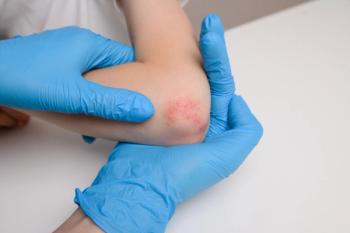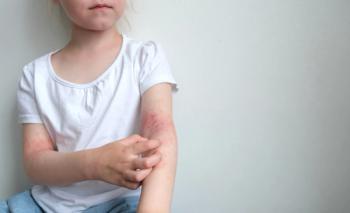
Plaque Psoriasis Nonsteroidal Treatment Options
Linda Stein Gold, MD explains in nonsteroidal treatment options for plaque psoriasis.
The current treatment landscape for plaque psoriasis includes numerous topical agents that target irritation, including roflumilast cream, a topical phosphodiesterase 4 (PDE4) inhibitor, and tapinarof cream, an aryl hybrid hydrocarbon reductase agonist. As Linda Stein Gold, MD, director of dermatology clinical research at Henry Ford Health System in Detroit, Michigan, explains in Nonsteroidal Treatment Options for Plaque Psoriasis, a Dermatology Times® DermView series, a group of psoriasis experts once met to publish updated psoriasis treatment guidelines. The researchers found that only a few topical treatments achieve the highest level of evidence, including topical corticosteroids, topical vitamin D analogs such as cyclosporine, topical vitamin A such as bexarotene, the combination of a steroid and vitamin D, or the combination and vitamin A.
“When we look at our options, especially our nonsteroidal options, these are commonly not used as monotherapy for plaque psoriasis because, for monotherapy, they haven’t been shown to be great heavy hitters. We worry about the irritation profile and the good news is that we have 2 new FDA-approved nonsteroidal topical agents. The first 1 is roflumilast, and this is a topical PDE4 inhibitor,” said Stein Gold.
Jennifer Soung, MD, director of dermatology clinical research at Southern California Dermatology in Santa Ana, explains that not all PDE4 inhibitors are the same.
“When I was an investigator and I started the clinical trials on topical roflumilast, I was curious whether it was going to work as a topical at all because we already had crisaborole, which wasn’t the most effective topical PDE4. As a target, I didn’t know if this was going to work at all, but in my own patients, I was pleasantly surprised. It worked better than I thought because the PDE4 that roflumilast is targeting is different,” said Soung.
Stein Gold explains that PDE4 inhibitors are commonly misunderstood as working outside the cell like biologics. Instead, PDE4 inhibitors work inside the cell to break down cyclic adenosine monophosphate and help modulate that inflammatory environment.
The clinical trials of topical roflumilast, DERMIS-1 (NCT04211363) and DERMIS-2 (NCT04211389), included 2 groups: the roflumilast active treatment group and the vehicle group. The primary end point was an Investigator Global Assessment (IGA) score of almost clear with at least a 2-grade improvement at week 8.
“We know that patients with psoriasis have the typical itchiness on the scalp, elbows, knees, and legs, but they can also have those skin folds. Sometimes it’s tricky because you look at it and you say, Is this intertrigo or is this psoriasis? If they have psoriasis elsewhere, then it’s probably psoriasis. If you look at the periphery, you can see the typical scaling sometimes, but in the skin folds, it can look very different. Those are the tough patients because we can’t use a potent steroid there,” said Stein Gold.
When applying the topical roflumilast once daily, over 40% of patients achieved almost clear at week 8 in the DERMIS-1 and DERMIS-2 trials. Both studies achieved IGA success.
“Something else that my patients find distressing is the itch. A lot of times when we think that psoriasis is not as itchy when we compare it with atopic dermatitis, but certainly, that is the primary complaint that our patients with plaque psoriasis have,” said Soung.
Soung mentioned that many patients noticed itch relief as early as week 2. In the DERMIS-1 and DERMIS-2 trials, approximately 67% of patients had at least a 4-point improvement in their itch score at week 8. Both Soung and Stein Gold noted that improvement at week 8 is meaningful when patients have plaque psoriasis in sensitive areas such as underneath the breast or the genital area.
“One thing that we touched on is the adverse effect profile. Is this something that we worry about any systemic absorption? Do we worry about systemic side effects? We know that the adverse effect profile is not much different than the vehicle itself. A few things that we think about with a PDE4 inhibitor, like headaches and diarrhea, were mild and generally resolved with time, and people were not dropping out because of systemic adverse effects. What is more important is the tolerability issue. Now we have a topical cream that we use once a day for psoriasis, yet the adverse effect profile in terms of tolerability was well tolerated,” said Stein Gold.
Soung also discussed the exciting ongoing clinical trials of roflumilast foam for scalp and body psoriasis. Soung was impressed that the foam formulation was able to penetrate thick, micaceous skin, especially in patients who have severe psoriasis of the scalp. Both Soung and Stein Gold are looking forward to FDA approval soon.
Another FDA-approved nonsteroidal topical agent, tapinarof cream, is an aryl hybrid hydrocarbon reductase agonist that also works inside the cell.
“This receptor is ligand dependent. It acts in different ways depending on who is binding to it. When tapinarof binds to this receptor, we see a downregulation of Th17 cytokines, which is important for psoriasis. We see a decrease in oxidative stress; we see an improvement in skin barrier proteins and a downregulation of Th2 cytokines. We’re not talking about atopic dermatitis here, but both roflumilast and tapinarof are currently in phase 3 clinical trials for atopic dermatitis,” said Stein Gold.
Soung explained that the active ingredient in tapinarof cream was isolated from the small intestines of a roundworm. In the PSOARING 1 (NCT03956355) and 2 (NCT03983980) clinical trials, the phase 3 program looked specifically at adult patients with plaque psoriasis. In topical studies, they included a range of severity levels from mild and moderate to severe. The affected body surface area ranged from 3% to 20%. The primary end point of the study aimed for a Physician’s Global Assessment response defined as 0 or 1. Patients saw a 2-grade improvement by week 12.
“I highlight week 12 because I want to set our patients’ expectations,” Soung said. “We want to make sure that they don’t stop using this topical before it has a chance to work. To just give you an idea of the type of patients in this study, the majority were your moderate plaque psoriasis patients, which is that red, classic, scaly plaque. They also had about 8% of patients who were severe.”
Both Stein Gold and Soung concluded their discussion by agreeing that they are excited about the new topical treatment options of roflumilast and tapinarof and how these treatment options can positively impact their patients.
Reference
1. Stein Gold L, Soung J. Dermatology Times® DermView. Non-steroidal treatment options for plaque psoriasis. December 15, 2022. Accessed January 5, 2023.
Newsletter
Pharmacy practice is always changing. Stay ahead of the curve with the Drug Topics newsletter and get the latest drug information, industry trends, and patient care tips.











































































































































































































